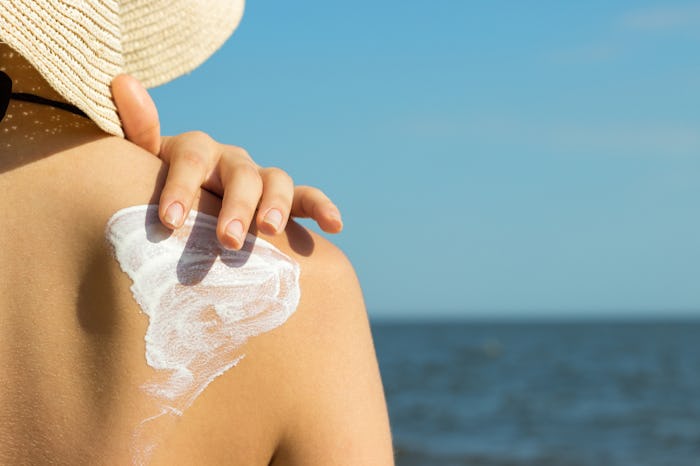I don't remember many times in my childhood when I was forced to or even asked to wear sunscreen, although I hope I was. In high school, I worked as a lifeguard, and we did wear sunscreen and a hat every day, but sun protection shirts weren't on our radar (or maybe even invented). Nowadays, many kids are covered from head to toe at the beach and playground to protect them from sun damage, but it can be tricky to know how you're actually being protected. First you need to know the difference between SPF and UPF, because they're the two systems you'll likely use the most.
SPF is the system used to rate sunscreen, whereas UPF is the system used to rate protective clothing. SkinCancer.org explained, "UPF stands for Ultraviolet Protection Factor. It indicates what fraction of the sun's rays can penetrate the fabric." They said that a shirt that has a UPF of 50 only lets 1/50th of the sun's rays through. SPF, on the other hand, stands for Sun Protection Factor. "It is a rating for sunscreens and other cosmetic products containing sunscreen. Theoretically, the SPF number indicates how long you can stay in the sun before your skin reddens," according to SkinCancer.org.
U.S. News and World Report explained that all clothing provides some sun protection, but certain items are treated with chemicals to add to their protective abilities. "A standard white T-shirt has an SPF of 7, which decreases to 3 when wet," they said. Certain sun protection clothing offers up to UPF 50, and in fact protects from both UVA and UVB rays. "UVA rays, which penetrate deep into the skin, are responsible for tanning. UVB rays damage superficial skin cell layers, causing sunburn," according to Harvard Health Publishing of Harvard Medical School. In comparison, sunscreen typically only protects from UVB rays. Some companies are now beginning to offer protection from some UVA rays, and for this type of protection you'll want to look for a 'broad spectrum' sunscreen.
Protecting our kids (and ourselves) from skin damage is high at the top all our minds, especially in the thick of summer months when the last thing you feel like doing is slathering your squirmy kids in sunscreen every 30 minutes. But slather we must, especially the parts of their bodies that can't be covered with UPF clothing. Likewise, we can't assume our kids don't need sunscreen just because they're wearing rash guards that are UPF 50. SunDoctors, a skin cancer clinic in Australia, suggested, "It's crucial to also apply high factor sunscreen to any areas that aren't already covered by your clothing, hat, or high-rated sunglasses."
What else can you do to protect yourself and your kids from sun damage? Avoid going out into the sun in the middle of the day. The Occupational Health and Safety Administration (OSHA), explained that the sun's rays are the strongest between 10 a.m. and 4 p.m., and that limiting exposure to the sun's rays is the best way to protect yourself and your kids from skin damage. Those are the times to seek out activities at your local library or even put on a movie indoors to keep your kids protected from the sun. Get outside as much as possible in the early morning and early evening in order to avoid skin damage from the sun.
You should also be conscious about your hat choice. OSHA recommended wide-brim hats over baseball caps, "because it protects the neck, ears, eyes, forehead, nose and scalp." Additionally, wearing "UV-absorbent sunglasses can help block UVA and UVB rays from the sun. However, that suggestion is likely for the parent or older child, because most young kids won't keep sunglasses on for more than a few seconds before they're flung into the sand or splash pad.
